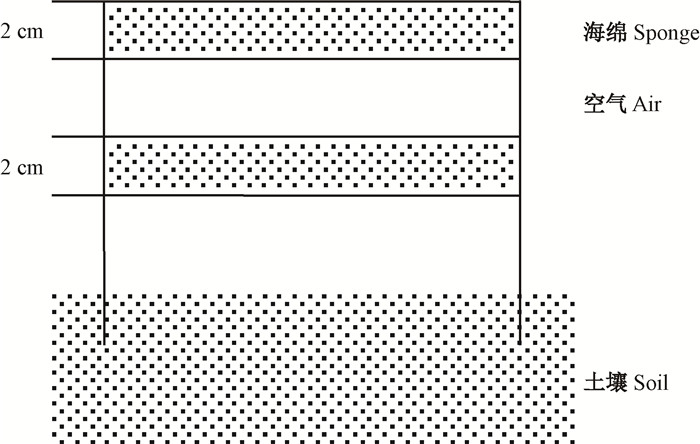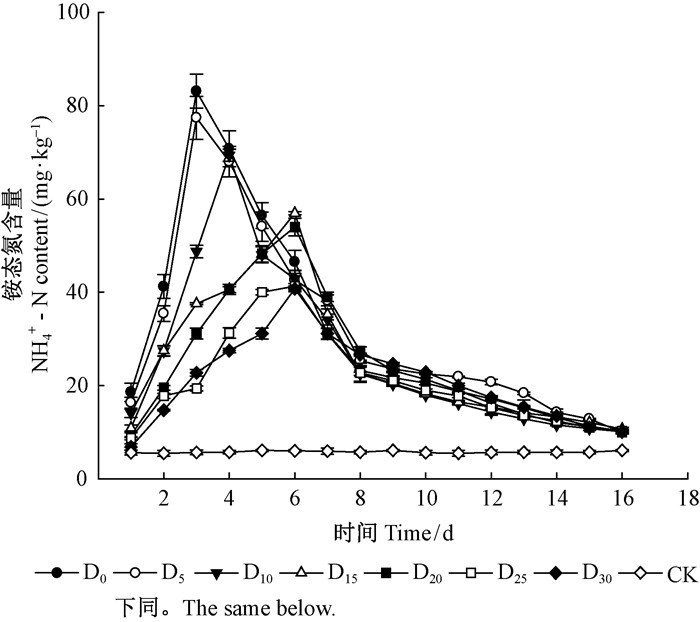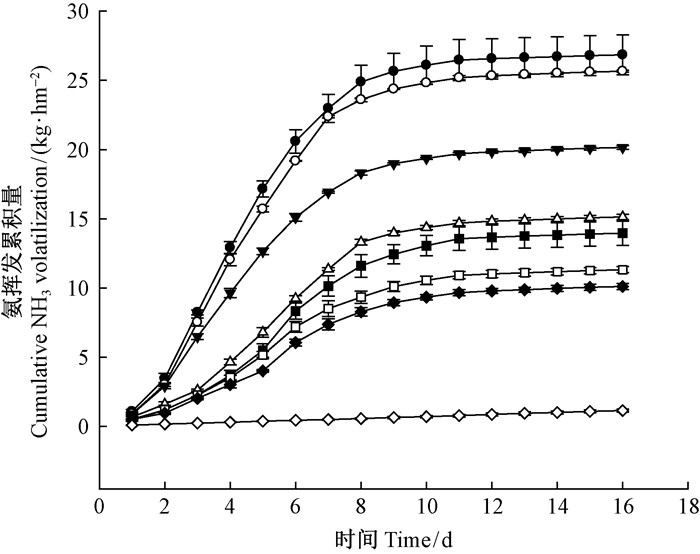文章信息
- 赵建诚, 苏文会, 范少辉, 蔡春菊, 朱晓武, 刘广路
- Zhao Jiancheng, Su Wenhui, Fan Shaohui, Cai Chunju, Zhu Xiaowu, Liu Guanglu
- 肥培毛竹林土壤氨挥发特征
- Characteristics of Soil Ammonia Volatilization in Fertilized Moso Bamboo (Phyllostachys edulis) Forests
- 林业科学, 2016, 52(11): 55-62
- Scientia Silvae Sinicae, 2016, 52(11): 55-62.
- DOI: 10.11707/j.1001-7488.20161107
-
文章历史
- 收稿日期:2015-11-13
- 修回日期:2016-04-14
-
作者相关文章
2. 西南林业大学 昆明 650224
2. Southwest Forestry University Kunming 650224
毛竹(Phyllostachys edulis)是我国分布面积最广、栽植和利用历史最悠久的竹种。根据第八次全国森林资源清查,我国毛竹林面积443万hm2,占竹林总面积的74%。当前,木材供需矛盾日益突出、环境压力不断加大,毛竹具有生长快、周期短、材质坚韧和永续利用等诸多优势(周芳纯,1998;江泽慧,2002),在我国农林业乃至整个国民经济发展中发挥着越来越重要的作用。但是,毛竹林连年采竹挖笋、养分归还量少等特点使其长期生产力难以维持。因此,营养元素的及时补充(施肥)成为毛竹林长期生产力维持的重要手段。
氮是毛竹生长需求量最大的元素(顾小平等,2004;郭晓敏等,2007;苏文会等,2013),在各个生长时期吸收量均最多(苏文会,2012)并参与毛竹的各种代谢活动,因此氮肥投入是毛竹林丰产的基础。然而,从当前竹林经营状况来看,施肥量的盲目增加和不恰当的施用方式加速氮素利用率的进一步降低,同时也带来诸多环境和生态问题(Zhao et al..,2006;Ju et al., 2009;2011;Guo et al., 2010;Reay et al., 2012)。氮肥施入土壤后,未被植物吸收的氮素通过氨挥发、地表径流、淋溶以及硝化与反硝化作用等途径而损失(Abbadie,2006;Lin et al., 2007;Xiong et al., 2010;Wallace et al., 2012), 其中,氨挥发损失是氮素损失的主要途径(Das et al., 2009;Xu et al., 2012;Huang et al., 2015)。研究表明,在有利于氨挥发的环境条件下,通过氨挥发损失的氮素相当于氮素总损失的71%(Zhu,1992)。挥发的氨气会随降雨重新进入生态系统而引起水体富营养化等环境问题(Sommer et al., 1995)。同时,氨气还是PM2.5的重要前体物质(Arogo et al., 2003)。因此,如何减轻氨挥发损失、提高氮素利用率,成为当前的重点研究问题。
目前,关于毛竹林施肥技术已有较深入的研究。但与世界化肥协会所提出生态施肥4R原则(IFA,2009)相比,正确施肥区域的研究仍相当薄弱,施肥深度的不恰当成为限制毛竹林施肥技术发展的瓶颈。氮肥深施可有效降低氨挥发损失,提高氮素利用率(曹兵等,2001;王朝辉等,2002),但这些研究也主要集中在农田中,而对毛竹林土壤氨挥发特征的研究还鲜有报道。因此,本试验对肥培毛竹林的土壤氨挥发特征及施肥深度的影响进行研究,从降低氨挥发损失的角度出发,为毛竹林合理施肥深度的确定、氮素利用率的提高以及生态环境保护提供科学指导。
1 材料与方法 1.1 研究区概况研究区位于安徽省黄山市黄山公益林场(118°14′-118°21′E,32°4′-32°10′N)。该区年均气温15.3 ℃,年均降水量1 500 mm,雨量集中,春夏多,秋冬少,相对湿度在80%以上,无霜期220天,年日照时数1 752.7 h。土壤为山地黄壤,土层厚度60 cm以上。土壤理化性质见表 1。
|
|
试验林为成片毛竹纯林,经营方向以材用为主,兼顾笋用,大小年明显。抚育措施以除草和隔年(小年冬季)采伐为主。林下植被主要有黄山杜鹃(Rhododendron maculiferum subsp. anhweiense)、石楠(Photinia serrulata)、白背叶(Mallotus apelta)、盐肤木(Rhus chinensis)、鼠刺(Itea chinensis)、算盘子(Glochidion puberum)、掌叶覆盆子(Rubus chingii)、铁芒萁(Dicranopteris dichotoma)、贯众(Cyrtomium fortunei)、五节芒(Miscanthus floridulus)、狗脊蕨(Woodwardia japonica)、苎麻(Boehmeria nivea)、粗毛牛膝菊(Galinsoga quadriradiata)、平车前(Plantago depressa)等。
1.2 试验设计研究于2015年(小年)7月进行,该时期毛竹换叶基本完成,养分需求量大,代谢旺盛。试验共设置7个施肥处理,深度施肥分别为0 cm (D0)、5 cm (D5)、10 cm (D10)、15 cm (D15)、20 cm (D20)、25 cm (D25)和30 cm (D30),以不施肥处理作为空白对照(CK),每处理3次重复。样地面积为15 m×20 m,各样地四周分别设置3 m宽缓冲带。然后测定样地的坡向、坡度、海拔,同时对样地内毛竹进行每木调查,记录年龄、胸径、秆高等生长指标。样地概况见表 2。
|
|
肥料以尿素(含纯N 46.4%)、过磷酸钙(含P2O5 12%)及氯化钾(含K2O 60%)的形式施用,施用量分别为242、178和147 kg·hm-2(苏文会,2012)。施肥方式为沟施,即沿等高线每隔2 m开一条沟(20 cm宽),每块样地9条。肥料混合均匀后,平均分成9份,一次性均匀施入沟内,然后回填原土。其他田间管理措施基本一致。
1.3 试验方法 1.3.1 氨挥发的测定采用通气法进行氨挥发量的测定(王朝辉等,2002)。氨气捕获装置由高15 cm、内径10 cm的PVC硬质塑料管制成(图 1)。PVC管中分别放置2块浸以15 mL 2%硼酸(H3BO3)溶液的优质海绵(直径为11 cm、厚度为2 cm)。上层的海绵与管顶部相平,主要吸收外部空气中的氨气;下层的海绵距管底5 cm,吸收土壤中挥发的氨气。将氨挥发捕获装置放于施肥带(沟)上,施肥后当天开始采集土壤挥发的氨,每个样地随机放置3个。次日上午开始取样,然后每隔1天取样1次,直至检测不到氨挥发时,试验结束。取样时将下层海绵取出,装袋密封,同时换上另一块刚浸过硼酸的海绵,上层海绵则视其干湿情况进行更换。下层海绵样品带回实验室后,将其浸泡于300 mL 1.0 mol·L-1的KCl溶液,180 r·min-1,振荡30 min后,用0.01 mol·L-1的H2SO4滴定,计算氨挥发量及氨挥发速率。

|
图 1 田间氨挥发收集装置 Fig.1 Ammonia collecting device in field |
土壤样品的采集与氨挥发损失的测定(更换下层海绵)同时进行。在各标准样地内随机选择3条施肥带(沟),每条施肥带上随机选择1个样点,用土钻钻取0~40 cm土壤,然后将同一样地的土壤混合均匀,作为该样地的土壤样品。样品采集后置于便携式保温箱内带回实验室,去除石块、根系等杂质,4 ℃冰箱中保存并尽快测定。土壤铵态氮含量采用靛蓝比色法测定(鲍士旦,2005)。
1.4 数据处理利用SAS 9.0软件,采用单因素分析(ANOVA)和最小显著性检验(LSD)进行多重比较,运用SigmaPlot 10.0进行绘图,并对氨挥发累积量动力学曲线进行拟合。
2 结果与分析 2.1 土壤铵态氮含量尿素施入土壤后,在脲酶的作用下,水解生成铵态氮,而铵态氮是气态氨的前体物(底物)。土壤铵态氮含量的动态变化规律如图 2。毛竹林施肥后土壤铵态氮含量先升高后下降,最后趋于稳定,呈单峰曲线变化。不同施肥深度处理下,土壤铵态氮含量峰值出现时间不同。D0和D5处理于第3天达到峰值(分别为83.07和77.40 mg·kg-1),D10处理于第4天达到最大值(69.37 mg·kg-1),其余施肥处理在第6天时达到峰值。峰值之后,各施肥处理的铵态氮含量逐渐下降;随着施肥时间的延长,逐渐趋于稳定。

|
图 2 施肥后土壤铵态氮含量的动态变化 Fig.2 Dynamic changes in soil NH4+-N contents after fertilization |
由图 3可知,施肥后第2天即检测到挥发氨,且各施肥处理的氨挥发速率均呈现先升高后降低的趋势,与土壤铵态氮含量的变化同步;未施肥处理的氨挥发速率基本保持稳定。施肥深度对土壤氨挥发速率峰值的影响显著。其中,D0、D5和D10处理的氨挥发速率在第3天达到最大值(分别为4.77、4.51和3.56 kg·d-1hm-2),而D15、D20、D25和D30处理在第6天达到峰值(分别为2.44、2.84、2.03和2.04 kg·d-1hm-2);随后各施肥处理的氨挥发速率逐日降低,至第12天时降至未施肥处理水平并逐渐趋于稳定。说明氮肥深施延迟了氨挥发速率峰值的出现。各施肥处理的平均氨挥发速率均高于未施肥处理,且随着施肥深度的增加而逐渐降低,以表层施肥(D0)的平均氨挥发速率最大,为1.68 kg·d-1hm-2。显著性检验表明,D0处理与D5处理的平均氨挥发速率差异不显著(P>0.05);但D0处理与其他处理之间具有显著性差异(P < 0.05)。

|
图 3 不同施肥深度下氨挥发速率的变化 Fig.3 Changes of NH3 volatilization rate at different fertilization depths |
肥培毛竹林土壤氨挥发累积量见图 4。由图 4可知,在整个检测期间,施肥处理的氨挥发累积量显著高于未施肥处理,且各施肥处理的氨挥发累积量呈逐渐增加趋势,最后趋于平稳。毛竹林施肥后,前8天的氨挥发累积量呈快速上升趋势,第8天后氨挥发慢速积累。采用Elovish动力学方程(y=a+b lnt)对不同施肥处理的氨挥发累积量(y)与时间(t)进行拟合,获得了较好的拟合度(表 3)。拟合方程中,常数a为第1天的氨挥发量,a < 0说明第1天的氨挥发量极低甚至检测不到;常数b为斜率,即氨挥发量(y)随lnt变化的速率,可以用来表征不同施肥处理的氨挥发速率。本试验中,常数b随施肥深度的增加逐渐降低,说明随着施肥深度的增加,氨挥发速率呈下降趋势。

|
图 4 不同施肥深度下氨挥发累积量的变化 Fig.4 Changes of cumulative NH3 volatilization at different fertilization depths |
|
|
肥培毛竹林土壤的氨挥发损失量及损失率见表 4。不同施肥深度毛竹林土壤氨挥发损失总量为10.12~27.17 kg·hm-2。随着施肥深度的增加,氨挥发损失量呈下降趋势,以D0和D5处理最大,分别为27.17和25.66 kg·hm-2。显著性检验表明,D0、D5处理与其他处理的差异性分别达到显著水平(P < 0.05),但D15与D20处理间差异不显著(P>0.05)。氨挥发损失率与损失量呈现一致的变化趋势,即随施肥深度的增加逐渐降低。方差分析表明,D15与D20处理间氨挥发损失率未表现出显著差异性,但其他各施肥处理间的氨挥发损失率差异显著(P < 0.05)。其中,D0与D5处理的氨挥发损失率分别为21.05%和19.88%,约为施氮量的1/5。从地表施肥(0 cm)到施肥深度为20和30 cm,施入氮素的氨挥发损失率由21.05%分别下降到10.84%和7.82%,说明氮肥深施能显著减少氨挥发损失量、降低损失率。
|
|
由表 4和5可知,各施肥处理的氨挥发作用发生较快,1~8天的氨挥发量占试验期间氨挥发总量的81.93%~92.38%,9~16天的氨挥发量仅占7.62%~18.07%,说明试验期间氨挥发作用主要发生在施肥后的1~8天,随后逐渐减少,而不施肥处理各时间间隔内的氨挥发量相对较均匀。D0、D5和D10处理1~4天的氨挥发量高于5~8天的挥发量,而D15、D20、D25和D30处理1~4天的氨挥发量低于5~8天的挥发量。D20、D25和D30处理9~12天的氨挥发量显著高于其他施肥处理(P < 0.05),说明D20、D25和D30处理的氨挥发作用发生的时间较为持久。施肥后13~16天的氨挥发量只占试验期间氨挥发总量的1.07%~3.16%。
|
|
氨挥发受多种因子的综合影响,主要有气候条件、土壤性质、肥料种类和施用量及种植模式等(Sommer et al., 2004;Ma et al., 2010)。研究表明,随着施肥量、温度、土壤水分及pH的升高,土壤氨挥发量也增加(Liu et al., 2007;王珏等,2009;王桂良,2014)。本研究中,土壤铵态氮含量与氨挥发速率的变化趋势基本一致,即呈单峰曲线变化。尿素施入土壤后,有机质含量增加,微生物活动加强,土壤脲酶活性也随之升高,尿素转化为铵态氮的速度加快(Matsushima et al., 2009);同时,在施肥量大、施肥部位集中时,由于氨化作用,尿素水解为碳酸铵,使施肥沟附近的土壤暂时变为碱性区域,短期内有利于氨的挥发。但随着时间的推移,施肥沟附近土壤pH的下降,抑制了尿素的水解,作为底物的铵态氮含量迅速下降,减缓氨化过程的进行。各施肥处理的氨挥发速率先升高后降低,分别于施肥后第3天(0、5和10 cm)和第6天(15、20、25和30 cm)达到最大值。试验期间,各施肥深度土壤温度差异较小,但土壤含水量随深度的增加逐渐增大,较高的土壤水分含量降低了土壤液相中铵态氮浓度(Søgaard et al., 2002;王朝晖等,2002),从而降低了氨分压和氨挥发速率。因此,深层施肥比浅层施肥的氨挥发速率峰值出现晚。
各施肥处理的氨挥发累积量逐渐增加,前8天的氨挥发量占挥发总量的80%以上,为快速上升阶段,第8天后氨挥发慢速积累(周静等,2008)。试验结束后,各施肥处理的氨挥发损失量随施肥深度的增加逐渐下降,0和5 cm深度施肥的氨挥发损失率约为施氮量的1/5,而有研究结果发现尿素地表施肥的氨挥发损失率高达52%(Sommer et al., 2004)。产生这种现象的原因主要有3方面:首先,土壤浅层的肥料暴露于温、湿度波动大、微生物活动频繁的微环境中,加速了尿素向铵态氮的水解,从而增加了氨的挥发(Zaman et al., 2004;王齐等,2011)。其次,氮肥深施增加了氨的扩散距离(Sommer et al., 1995),挥发的氨气通过土壤的时间较长或很难通过土壤进行扩散。最后,深层施肥产生的部分铵态氮被植物根系吸收的机会增大(Zaman et al., 2010),同时,也可能被土壤固定或通过淋溶向更深层的土壤移动而损失。因此,降雨前施肥或施肥后立即灌溉能有效减少氨挥发损失,通过水分下移达到氮肥深施的作用。
氨挥发是毛竹林氮素损失的重要途径,减少氨挥发损失可有效利用氮肥,提高氮素利用率。氮肥深施延缓了氨挥发速率峰值的出现,有效减少了氨挥发损失量,降低氨挥发损失率,但同时也增加了氮素的淋溶损失。合理施肥深度的确定,既要考虑到尽量减少氮素损失,又要考虑到能及时被植物根系吸收。毛竹为浅根系植物,鞭根主要分布在10~30 cm土层(江泽慧,2002;周本智等,2004)。本研究中,15 cm以下深度施肥的氨挥发损失均较低,但考虑到深层施肥可能导致淋溶损失,同时深层施肥也增加了生产成本。因此,综合考虑毛竹根系分布及氮素损失、利用情况,施肥深度应为15~20 cm土层。
4 结论施肥深度对氨挥发影响明显,平均氨挥发速率和挥发损失量随深度增加而逐渐降低。施肥后毛竹林土壤的氨挥发速率先升高后降低,呈单峰曲线变化;浅层施肥与深层施肥毛竹林氨挥发速率峰值出现时间不同。氨挥发过程可分为快速上升和慢速积累2个阶段,前8天的挥发量所占比重较大。表层(0 cm)和5 cm深度土层施肥毛竹林的氨挥发损失率较大,而在施肥深度超过15 cm时,损失率降幅明显减缓。综合考虑毛竹根系分布及氮素损失、利用情况,建议毛竹林的合理施肥深度为15~20 cm土层。
| [] |
鲍士旦. 2005. 土壤农化分析. 北京: 农业出版社 .
( Bao S D. 2005. Soil agro-chemistrical analysis. Beijing: China Agriculture Press . [in Chinese] ) |
| [] |
曹兵, 李新慧, 张琳, 等. 2001. 冬小麦不同基肥施用方式对土壤氨挥发的影响. 华北农学报 , 16 (2) : 83–86.
( Cao B, Li X H, Zhang L, et al.2001. Effect of different basal-dressing application methods on soil ammonia volatilization from winter wheat field. Acta Agriculturae Boreali-Sinica , 16 (2) : 83–86. [in Chinese] ) |
| [] |
顾小平, 吴晓丽, 汪阳东. 2004. 毛竹林氮素营养诊断的研究. 浙江林业科技 , 24 (2) : 1–4.
( Gu X P, Wu X L, Wang Y D.2004. Study on nutrient diagnoses of Phyllostachys heterocycla var. pubescens stand.Journal of Zhejiang Forestry Science and Technology , 24 (2) : 1–4. [in Chinese] ) |
| [] |
郭晓敏, 牛德奎, 范方礼, 等. 2007. 平衡施肥毛竹林叶片营养与土壤肥力及产量的回归分析. 林业科学 , 43 (sp.1) : 53–57.
( Guo X M, Niu D K, Fan F L, et al.2007. Regression analysis of leaf nutrition, soil fertility and output in bamboo forest of balance fertilization. Scientia Silvae Sinicae , 43 (sp.1) : 53–57. [in Chinese] ) |
| [] |
江泽慧. 2002. 世界竹藤. 沈阳: 辽宁科学技术出版社 .
( Jiang Z H. 2002. Bamboo and rattan in the world. Shenyang: Liaoning Science & Technology Publishing House . [in Chinese] ) |
| [] |
苏文会. 2012.基于生长和养分积累规律的毛竹林施肥理论与实践研究.北京:中国林业科学研究院博士学位论文. ( Su W H. 2012. Fertilization theory and practice for Phyllostachys edulis stand based on growth and nutrient accumulation rules.Beijing: PhD thesis of Chinese Academy of Forestry.[in Chinese][in Chinese]) http://cdmd.cnki.com.cn/Article/CDMD-82201-1012423711.htm |
| [] |
苏文会, 封焕英, 范少辉, 等. 2013a. 毛竹冬笋中氮、磷、钾含量的动态变化与积累规律. 林业科学研究 , 26 (2) : 252–256.
( Su W H, Feng H Y, Fan S H, et al.2013a. Dynamic changes and accumulation rules of N, P and K contents in winter shoot of Phyllostachys edulis. Forest Research , 26 (2) : 252–256. [in Chinese] ) |
| [] |
苏文会, 许庆标, 范少辉, 等. 2013b. 毛竹冬笋生长与生物量积累规律研究. 西北林学院学报 , 28 (2) : 32–36.
( Su W H, Xu Q B, Fan S H, et al.2013b. Winter shoot growth and biomass accumulation of Phyllostachys edulis. Journal of Northwest Forestry University , 28 (2) : 32–36. [in Chinese] ) |
| [] |
王桂良.2014.中国三大粮食作物农田活性氮损失与氮肥利用率的定量分析.北京:中国农业大学博士学位论文. ( Wang G L.2014.Quantitative analysis of reactive nitrogen losses and nitrogen use efficiency of three major grain crops in China.Beijing: PhD thesis of China Agricultural University.[in Chinese][in Chinese]) http://cdmd.cnki.com.cn/Article/CDMD-10019-1014221257.htm |
| [] |
王珏, 巨晓棠, 张丽娟, 等. 2009. 华北平原小麦季氮肥氨挥发损失及影响因素研究. 河北农业大学学报 , 32 (3) : 7–10.
( Wang J, Ju X T, Zhang L J, et al.2009. Ammonia volatilization of N fertilizer and influencing factors in the North China Plain. Journal of Agricultural University of Hebei , 32 (3) : 7–10. [in Chinese] ) |
| [] |
王齐, 师春娟. 2011. 草坪生态系统中氨挥发研究进展. 亚热带植物科学 , 40 (4) : 80–84.
( Wang Q, Shi C J.2011. Research progress of ammonia volatilization in turf ecosystem. Subtropical Plant Science , 40 (4) : 80–84. [in Chinese] ) |
| [] |
王朝辉, 刘学军, 巨晓棠, 等. 2002. 北方冬小麦/夏玉米轮作体系土壤氨挥发的原位测定. 生态学报 , 22 (3) : 359–365.
( Wang Z H, Liu X J, Ju X T, et al.2002. In situ determination of ammonia volatilization from wheat-maize rotation system field in north China. Acta Ecologica Sinica , 22 (3) : 359–365. [in Chinese] ) |
| [] |
周本智, 傅懋毅. 2004. 竹林地下鞭根系统研究进展. 林业科学研究 , 17 (4) : 533–540.
( Zhou B Z, Fu M Y.2004. Review on bamboo's under ground rhizome-root system research. Forest Research , 17 (4) : 533–540. [in Chinese] ) |
| [] |
周芳纯. 1998. 竹林培育学. 北京: 中国林业出版社 .
( Zhou F C. 1998. Cultivation of bamboo forest. Beijing: China Forestry Publishing House . [in Chinese] ) |
| [] |
周静, 崔键, 王霞. 2008. 红壤不同含水量对尿素氨挥发的影响. 土壤 , 40 (6) : 930–933.
( Zhou J, Cui J, Wang X.2008. Effects of red soil moisture on ammonia volatilization of urea. Soils , 40 (6) : 930–933. [in Chinese] ) |
| [] | Abbadie L.2006.Nitrogen inputs to and outputs from the soil-plant system//Lamto.Springer New York, 255-275. |
| [] | Arogo J, Westerman P W, Heber A J.2003. A review of ammonia emissions from confined swine feeding operations. Transactions of the ASAE , 46 (3) : 805–817. |
| [] | Das P, Sa J H, Kim K H, et al.2009. Effect of fertilizer application on ammonia emission and concentration levels of ammonium, nitrate, and nitrite ions in a rice field. Environmental Monitoring and Assessment , 154 (1/4) : 275–282. |
| [] | Guo J H, Liu X J, Zhang Y, et al.2010. Significant acidification in major Chinese croplands. Science , 327 (5968) : 1008–1018. DOI:10.1126/science.1182570 |
| [] | Huang P, Zhang J, Zhu A, et al.2015. Coupled water and nitrogen (N) management as a key strategy for the mitigation of gaseous N losses in the Huang-Huai-Hai plain. Biology and Fertility of Soils , 51 : 333–342. DOI:10.1007/s00374-014-0981-0 |
| [] | IFA.2009.The Global "4R" nutrient stewardship framework: developing fertilizer best management practices for delivering economic, social and environmental benefits.International Fertilizer Industry Association (IFA), Paris, France. |
| [] | Ju X T, Xing G X, Chen X P, et al.2009. Reducing environmental risk by improving N management in intensive Chinese agricultural systems. Proceedings of the National Academy of Sciences , 106 (9) : 3041–3046. DOI:10.1073/pnas.0813417106 |
| [] | Ju X T, Christie P.2011. Calculation of theoretical nitrogen rate for simple nitrogen recommendations in intensive cropping systems: a case study on the North China Plain. Field Crops Research , 124 (3) : 450–458. DOI:10.1016/j.fcr.2011.08.002 |
| [] | Lin D X, Fan X H, Hu F, et al.2007. Ammonia volatilization and nitrogen utilization efficiency in response to urea application in rice fields of the Taihu Lake region, China. Pedosphere , 17 (5) : 639–645. DOI:10.1016/S1002-0160(07)60076-9 |
| [] | Liu G D, Li Y C, Alva A K.2007. Moisture quotients for ammonia volatilization from four soils in potato production regions. Water, Air, and Soil Pollution , 183 (1/4) : 115–127. |
| [] | Ma B L, Wu T Y, Tremblay N, et al.2010. On-farm assessment of the amount and timing of nitrogen fertilizer on ammonia volatilization. Agronomy Journal , 102 (1) : 134–144. DOI:10.2134/agronj2009.0021 |
| [] | Matsushima M, Lim S S, Kwak J H.2009. Interactive effects of synthetic nitrogen fertilizer and composed manure on ammonia volatilization from soils. Plant and Soil , 325 (1/2) : 187–196. |
| [] | Reay D S, Davidson E A, Smith K A, et al.2012. Global agriculture and nitrous oxide emissions. Nature Climate Change , 2 (6) : 410–416. DOI:10.1038/nclimate1458 |
| [] | Sommer S G, Hutchings N.1995. Techniques and strategies for the reduction of ammonia emission from agriculture. Water, Air, and Soil Pollution , 85 (1) : 237–248. DOI:10.1007/BF00483704 |
| [] | Sommer S G, Schjoerring J K, Denmead O T.2004. Ammonia emission from mineral fertilizers and fertilized crops. Advances in Agronomy , 82 : 557–622. DOI:10.1016/S0065-2113(03)82008-4 |
| [] | Søgaard H T, Sommer S G, Hutchings N J, et al.2002. Ammonia volatilization from field-applied animal slurry-the ALFAM model. Atmospheric Environment , 36 (20) : 3309–3319. DOI:10.1016/S1352-2310(02)00300-X |
| [] | Wallace J, Karim F, Wilkinson S.2012. Assessing the potential underestimation of sediment and nutrient loads to the Great Barrier Reef lagoon during floods. Marine Pollution Bulletin , 65 (4) : 194–202. |
| [] | Xiong Z Q, Huang T Q, Ma Y C, et al.2010. Nitrate and ammonium leaching in variable-and permanent-charge paddy soils. Pedosphere , 20 (2) : 209–216. DOI:10.1016/S1002-0160(10)60008-2 |
| [] | Xu J, Peng S, Yang S, et al.2012. Ammonia volatilization losses from a rice paddy with different irrigation and nitrogen managements. Agricultural Water Management , 104 : 184–192. DOI:10.1016/j.agwat.2011.12.013 |
| [] | Zaman M, Blennerhassett J D, Saggar S.2010. Effects of the different rates of urease and nitrification inhibitors on gaseous emissions of ammonia and nitrous oxide, nitrate leaching and pasture production from urine patches in an intensive grazed pasture system. Agriculture Ecosystems & Environment , 136 (3/4) : 236–246. |
| [] | Zaman M, Matsushima M, Chang S X, et al.2004. Nitrogen mineralization, N2O production and soil microbiological properties as affected by long-term applications of sewage sludge composts. Biology and Fertility of Soils , 40 (2) : 101–109. DOI:10.1007/s00374-004-0746-2 |
| [] | Zhao R F, Chen X P, Zhang F S, et al.2006. Fertilization and nitrogen balance in a wheat-maize rotation system in North China. Agronomy Journal , 98 (4) : 938–945. DOI:10.2134/agronj2005.0157 |
| [] | Zhu Z L.1992. Efficient management of nitrogen fertilizers for flooded rice in relation to nitrogen transformations in flooded soils. Pedosphere , 2 (2) : 97–114. |
 2016, Vol. 52
2016, Vol. 52

